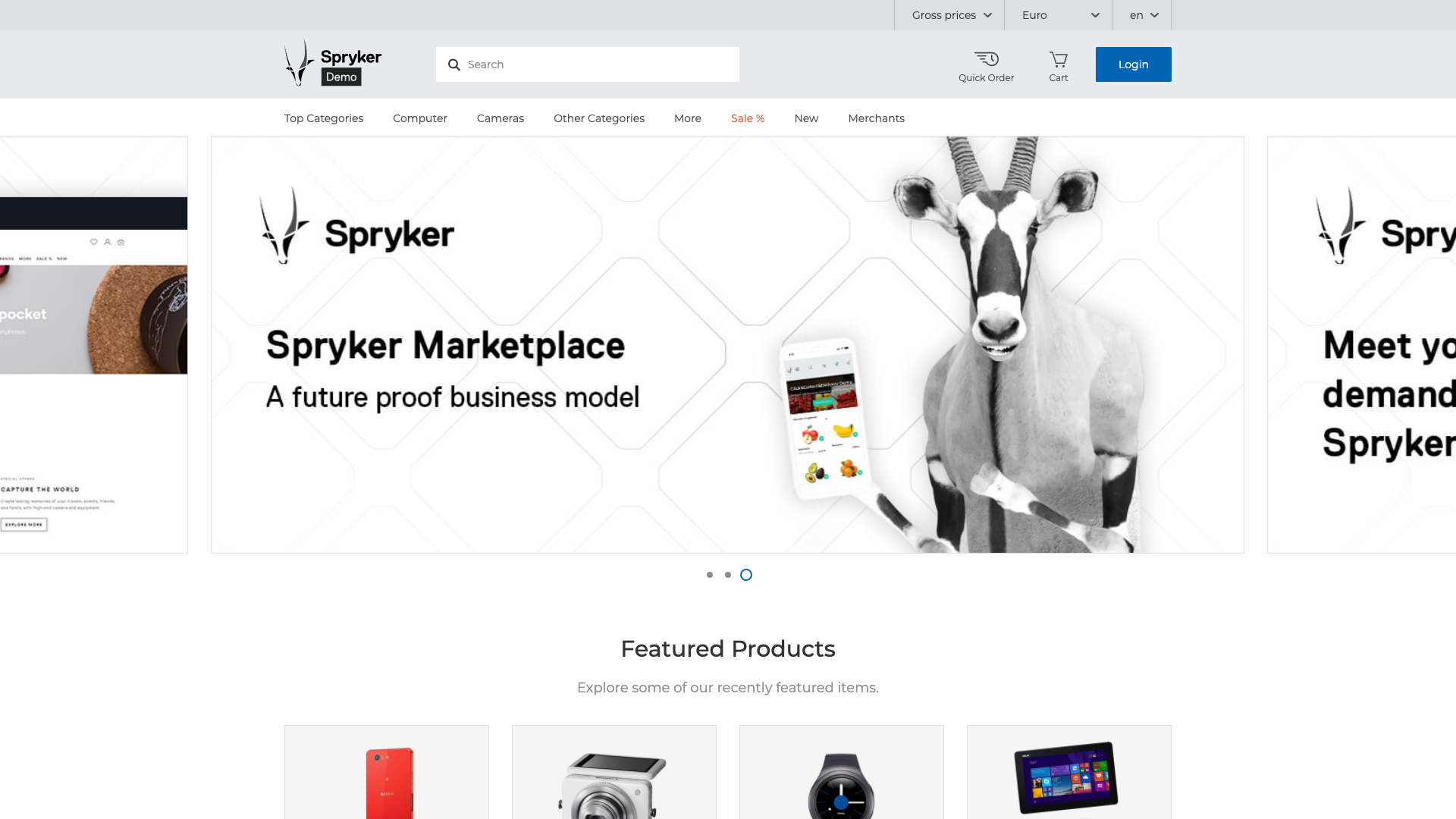We want to become the Amazon for the component trading industry. Customers have been suffering from a lack of transparency for too long. It’s time to remove borders and sell and purchase components through an e-commerce marketplace.

Everything you need to know about building a Multi-Vendor Marketplace
Multi-Vendor Marketplaces offer immense growth potential for businesses within B2C and B2B industries. By adopting a marketplace model, companies have the opportunity to scale at a much quicker pace while reducing risk. Read our guide to get a comprehensive walk-through of multi-vendor marketplace business models, benefits, and concrete solutions with Spryker:

-
CHAPTER 01 - Introduction to Multi-Vendor Marketplaces: How does a Marketplace work and what are the roles of the Marketplace Operator & Merchants
-
CHAPTER 02 - The Benefits of Starting a Multi-Vendor Marketplace: Benefits for the Operator, for your Merchant, and for your Customers
-
CHAPTER 03 - Getting Started with Spryker’s Marketplace Suite: The Merchant Portal, the Marketplace Storefront and the Back Office for Marketplace Operator
An Error occured while trying to load the form. Please reload the Browser to try it again.
Thinking about starting a Multi Vendor Marketplace?
Reduce risk and scale faster. A marketplace platform offers great potential for your business. Download the guide for everything you need to know about multi vendor marketplaces.

Transform your business with a Multi Vendor Marketplace
- Increase ROI
- Differentiate
- Decrease costs
- Increase Agility
- Improve Convenience
Increase ROI
Adding merchants to your existing platform introduces new streams of revenue, and requires fewer resources and investments than stocking and managing your own products. Plus, receive commissions on successful sales.

Differentiate your offerings
Growing the number of merchants on your platform helps you stand out and diversify your product offerings, while introducing and testing new, niche products without any risk or stock commitments.

Decrease CAC and IT cost
Leverage merchants on your platform to drive down customer acquisition and IT costs for all parties involved, and in the process, provide a better experience to your joint customers.

Increase Agility
All capabilities in one platform mean seamless upgrades and effortless iteration, for even the most sophisticated business models.

Improve Customer Convenience
Expand product offerings and provide an intuitive transactional experience that helps customers buy more with less effort.

How does a Multi-Vendor Marketplace work
Looking to streamline your business processes and boost sales? At Spryker, we’ve got you covered. Our Multi-Vendor Marketplace solution is designed to simplify complex transactions, connect businesses with buyers, and increase revenue.
With Spryker’s Multi-Vendor Marketplace, you can create a digital ecosystem that connects suppliers and buyers, facilitating transactions, and improving efficiency. Watch the video for a step-by-step breakdown of how our B2B Marketplace solution works.

-
How are Multi-Vendor marketplaces different from regular e-commerce stores?
Multi-vendor marketplaces provide businesses with a platform that offers much more than regular e-commerce stores. In addition to storefronts, automated processes, secure transactions, virtual support, and global brand exposure, marketplaces offer several advantages, such as:
- Increased customer trust: Multi-vendor marketplaces can help build customer trust by providing a centralized platform for transactions and offering buyer protection policies that protect customers from fraud and scams.
- Lower startup costs: Setting up an e-commerce store from scratch can be expensive, especially for small businesses. By contrast, multi-vendor marketplaces typically charge lower fees and require less investment in infrastructure and marketing.
- Access to valuable data: Marketplaces can provide valuable insights into customer behavior and preferences, which can help businesses optimize their marketing strategies and product offerings.
- Opportunities for collaboration: Multi-vendor marketplaces can provide opportunities for businesses to collaborate and cross-promote each other’s products, which can lead to increased sales and brand exposure.
- Flexibility and scalability: Marketplaces can offer businesses greater flexibility and scalability, as they can easily add or remove products and adjust their pricing and marketing strategies to respond to changing market conditions.
One of the primary benefits of a marketplace is the ability to have several merchants selling products on one platform. This results in a more extensive range of products, competitive pricing, and solutions to supply chain issues by providing multiple product and material sources from various locations.
In the manufacturing industry, specialized marketplace technology can assist businesses in managing their revenue better by optimizing warehouse space through advanced inventory management.
-
What are the benefits of Multi-Vendor marketplaces?
Multi-vendor marketplaces provide a variety of benefits for businesses, including:
- Access to a wider, captivated audience of potential customers.
- Lower startup costs compared to setting up an independent e-commerce store.
- Greater opportunities for collaboration and cross-promotion with other businesses.
- Increased trust among customers due to centralized transaction processing and buyer protection policies.
- Access to valuable data on customer behavior and preferences to optimize marketing and product strategies.
- Enhanced flexibility and scalability for adjusting product offerings and pricing strategies to respond to market conditions.
- Greater product and service availability through multiple suppliers and vendors.
- Competitive pricing due to the variety of sellers on the platform.
- Expedited shipping and delivery for improved customer satisfaction.
- Guaranteed performance through seller ratings and review systems.
Additionally, multi-vendor marketplaces can offer specialized technology to assist businesses in managing their revenue better, such as advanced inventory management for optimizing warehouse space.
-
How do you manage marketplace merchants on a B2B marketplace?
The Spryker Merchant Portal is the management interface for third-party Merchants and enables them to take care of all administrative tasks in one place.
- The merchant can register and edit a merchant profile that contains contact details, shop descriptions with logos and banners, and legal information.
- In the Merchant Portal, merchants can list their products and individual offers for existing products in the marketplace.
- They can keep track of all incoming orders and manage order statuses for their customers.
- A dashboard function provides the latest sales reports.
Benefit: Expand your business and save costs by allowing merchants to create and manage their offers.
-
How to build a Multi-Vendor marketplace?
Building a multi-vendor marketplace involves several steps, including:
- Choosing a niche and identifying the target market.
- Selecting a suitable e-commerce platform, such as Spryker, that supports multi-vendor functionality.
- Configuring the e-commerce platform to enable multi-vendor functionality and installing any necessary extensions or plugins.
- Setting up the payment and shipping systems to enable transactions between buyers and sellers.
- Developing a user-friendly interface for vendors to manage their storefronts and product listings.
- Establishing policies and procedures for handling disputes and ensuring seller compliance.
- Marketing the marketplace to attract both buyers and sellers.
- Providing ongoing support and maintenance to ensure the marketplace runs smoothly.
It’s essential to have a clear plan and strategy in place before embarking on building a multi-vendor marketplace to ensure that it meets the needs of both buyers and sellers and is sustainable in the long term. Working with an experienced e-commerce development team can help streamline the process and ensure the marketplace’s success.
-
Why is Spryker an ideal platform choice for a multi-vendor marketplace?
Spryker is an ideal platform choice for a multi-vendor marketplace for several reasons:
- Modular architecture: Spryker’s modular architecture allows for flexibility in creating and customizing different features and functionality needed for a multi-vendor marketplace.
- Multi-store management: Spryker supports the creation and management of multiple stores with different catalogs, pricing, and branding, enabling vendors to have their storefronts within the same marketplace.
- Powerful back-office management: Spryker’s back-office management system allows vendors to manage their inventory, orders, and shipping within the same platform.
- Comprehensive storefront capabilities: Spryker offers a wide range of storefront capabilities, including product catalogs, search, shopping cart, and checkout, making it easy for vendors to create and manage their storefronts.
- Scalability: Spryker is highly scalable, allowing multi-vendor marketplaces to grow and expand without limitations.
- Extensive integrations: Spryker has extensive integrations with leading third-party providers for payments, shipping, and other e-commerce functionalities, making it easier to build and manage a multi-vendor marketplace.
Overall, Spryker’s flexibility, scalability, and comprehensive features make it an ideal platform choice for businesses looking to create a robust and customizable multi-vendor marketplace.
Learn from Spryker Customers
We accelerate businesses just like yours.
-

-
"At peak times, we record, on average, 4,000 to 4,800 orders a day. And there’s always surges and spikes – like just before order cutoff time when all of our customers log in at once. And with 8,000 users, as we have in the shop, that can mean a fair amount of traffic. Our shop system must be able to handle this surge in demand."
Gérard Georges
-
"Thanks to Spryker's flexible and modular architecture, we were able to implement the launch and further development using an agile MVP approach. We couldn't find any other provider that had the solid API-first approach with the combination of mobile app and merchant platform in this form, and we are excited to be able to now fully dedicate ourselves to Durst's growth."
Matthias Steinforth
-
"With Spryker, we found a perfect partner who was able to deliver the new e-commerce sales platform that we needed while sticking to the challenging timeline of less than three weeks."
Jens Brech
-
"Throughout our evaluation, Spryker was the one technology fulfilling over 90% of our high-complex use cases from the get-go. And it’s paid off so far!"
Jochen Hostalka
-

We use the Spryker solution as a front-end tool and connect it to our back-end systems via our APIs. The motivation for this cooperation was to amplify our technology, to scale faster and to provide our customers with this diversified range of functions.

Timo Salzsieder
CIO/CSO at METRO AG and CEO at METRONOM
Read their story ➜

Want to Know More About Multi Vendor Marketplaces?
Visit our Product Portal and find in-depth information regarding all available Spryker products, features and solutions for your business.
Marketplace Capabilities
Marketplace Feature Glossary
Spryker Technology
An Error occured while trying to load the form. Please reload the Browser to try it again.


